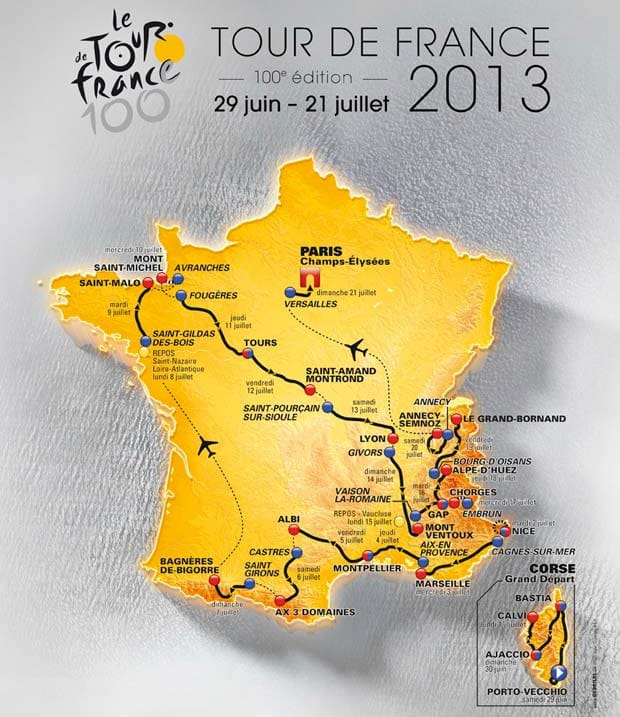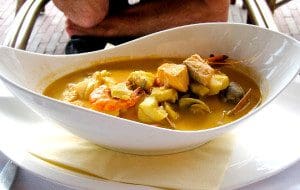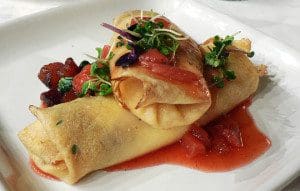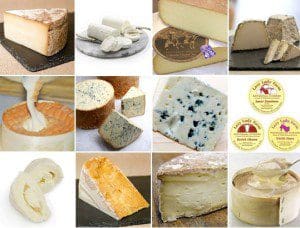 The most famous bicycle race in the world, the Tour de France, will be rolling through the French countryside for the 100th time this year. On June 29, the racers will start on the island of Corsica, then grind through 21 stages and more than 2,000 miles (over 3,400 km) of brutal mountain ascents, mercifully flat landscape and competitive time trials before victoriously streaming into Paris and down the Champs Elysées on July 21, 2013. As a bicycling aficionado, I’m in awe of the physical and mental prowess of the riders. As a traveler, I’m enchanted by the natural beauty of the scenery. As a person that appreciates good food and wine, the Tour de France is just one more reason to visit the country that is famous for its regional culinary specialties.
The most famous bicycle race in the world, the Tour de France, will be rolling through the French countryside for the 100th time this year. On June 29, the racers will start on the island of Corsica, then grind through 21 stages and more than 2,000 miles (over 3,400 km) of brutal mountain ascents, mercifully flat landscape and competitive time trials before victoriously streaming into Paris and down the Champs Elysées on July 21, 2013. As a bicycling aficionado, I’m in awe of the physical and mental prowess of the riders. As a traveler, I’m enchanted by the natural beauty of the scenery. As a person that appreciates good food and wine, the Tour de France is just one more reason to visit the country that is famous for its regional culinary specialties.
Regional Culinary Specialties of France
Corsica – For the first time ever, the Tour de France will begin in Corsica, aka the “Isle of Beauty.” Vacationers flock to the gorgeous beaches of Porto-Vecchio, but the riders will embark on a three-day zigzag across Corsica’s mountains in a race for the Yellow Jersey (individual time leader). Like the island culture itself, the unique regional culinary specialties are a blend of French and Italian influence. Corsican honey comes from a bee only found there and has a distinctive flavor depending on hive location. Brocciu is the Corsican national cheese best eaten very fresh, but only produced November through May. Charcuterie is pungent and smoky cured meat from the abundant free range pigs and wild boar on the island.

Provence and the French Riviera – Back on the mainland, the Tour will race through the flat, sun-drenched southeast of France, from Nice to Marseille to Montpelier. The high-end resorts of the colorful Riviera draw the rich and the beautiful, as well as those who aren’t either, but come for the traditional Provencal dishes like bouillabaisse (saffron-flavored fish soup common in Marseille), ratatouille (vegetable stew) and salade Nicoise (lettuce with vegetables, anchovies or tuna). Taking a cue from nearby Italy, regional cooking from this area tends to use olive oil rather than butter and is liberal with the garlic.
The Pyrenees of Southern France – After a week of racing, the riders will spend two punishing days climbing the Pyrenees Mountains near the Spanish border. The Polka Dot Jersey (awarded to the best climber) will be the coveted prize. Visitors to the areas near the Pyrenees and its summits enjoy mountain sports and nature. Though the Tour won’t technically enter Basque country, the regional culinary specialties of southern France are influenced by Basque and Spanish cuisine. Cassoulet (white beans and duck or goose confit, baked) as well as other small game birds and lamb are frequently served. Bayonne ham and Armagnac brandy come from southern France.

Brittany and Normandy – After the Pyrenees effort, the riders will fly to northwest France and have a day of rest then it’s back on the bike for stage 10-12. Fans will see the peloton roll by several symbols of French national life: The elite cadets of Saint-Cyr military school, the imposing Benedictine Abby and Mont Saint-Michel, France’s second most popular tourist attraction after the Eiffel Tower. Brittany is famous for crepes stuffed with both sweet and savory ingredients. Normandy is home to Camembert cheese and Calvados brandy. Apples are used in both hard cider and chicken Normandy, and shellfish is plentiful along the coast.
Burgundy & Rhone – Riders will have a couple long stages as they leave the Loire Valley, cross central France to Lyon. Team strategy will make all the difference in how their leader is positioned for the Alps that come next. The route skirts just south of Burgundy, but foodie visitors might detour to one of the many Michelin-starred restaurants of Burgundy to taste the signature boeuf bourguignon (beef stewed in red wine), coc au vin (chicken cooked in wine), escargot (snails) and the deep red wine named for the region.

Alpine – Riders will have a day of rest before they tackle 5 days of grueling climbs, including a first-ever double ascent of Alpe-d’Huez and a vicious time trial. For those who don’t need to prove their pedaling prowess, the rugged mountains of the French Alps are dotted with luxury ski resorts and high end spas. The regional culinary specialty is cheese, cheese and more cheese. Hundreds of local Alpine cheeses are made from cow, sheep and goat milk, some of the most famous being Comte, Reblochon and Vacherin Mont d’Or.
Paris – The teams will fly from the Alps to start the final stage of the Tour de France in the gardens of the Palace of Versailles. They’ll race into Paris, through the courtyard of the Louvre and victoriously down the Champs Elysées to arrive at the Arc de Triomphe at dusk. The finish will be marvelously exciting for the thousands of fans lining the route! Paris is the birthplace of haute cuisine and has one of the highest concentrations of Michelin-starred restaurants in the world. But for the simpler palate, a café au lait and pain au chocolat at an alfresco café is just as good.
To plan your own gastronomic Tour de France and experience its regional culinary specialties, contact Covington’s France specialists.
References:
The Terroir of Corsica and Corsican Specialty Foods






Leave a Reply